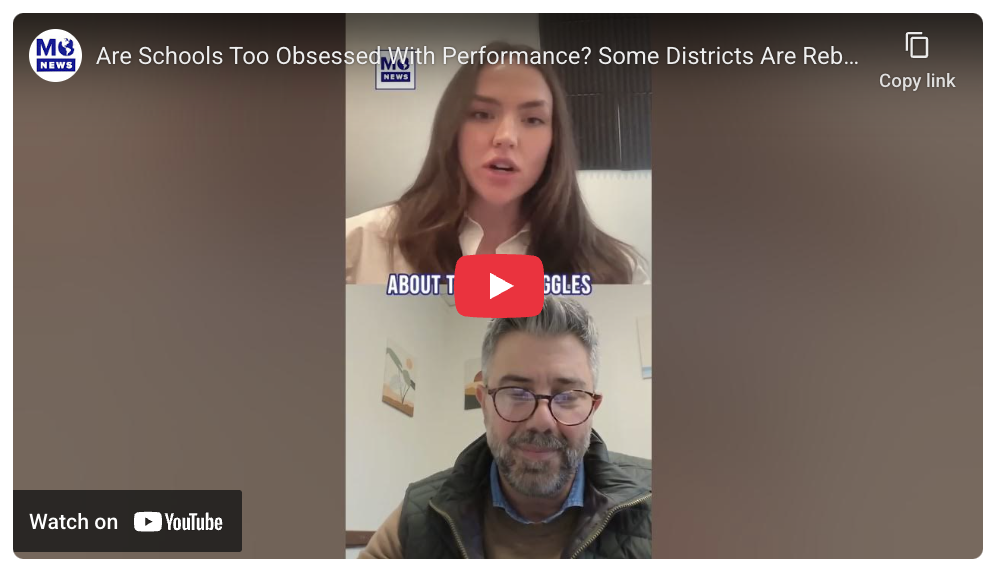Are The Kids Alright? A Nuanced Look At The State Of Schools
A recent viral New York Times essay — “America’s Children Are Unwell. Are Schools Part of the Problem?” — sparked a huge response from our audience.
The article, by writer Jia Lynn Yang, argues that spikes in childhood mental health, ADHD, and autism diagnoses can’t be explained only by biology, screens, or parenting — it’s also deeply tied to how school has been redesigned into a high-pressure, metrics-obsessed system, forcing kids into a one-size-fits-all academic track.
Mo News Producer Lauren Janes sat down with Dr. Peter Faustino, the former president of the National Association of School Psychologists (NASP) and a school psychologist with nearly 30 years of experience, to unpack what’s really going on inside schools.
ALARMING NUMBERS
The article opens with some staggering stats:
Nearly 1 in 4 17-year-old boys has an ADHD diagnosis
1 in 13 children has an autism diagnosis
32% of teens have been diagnosed with anxiety
1 in 10 teens has had a major depressive episode
Faustino says the numbers confirm what many in schools already know: “There has been a long-standing crisis among our youth — even prior to the pandemic… [and] our concern has only risen.”
But he also notes that “If a child is struggling in school, it doesn’t necessarily equate to a disorder.” Instead, he focuses on gathering good information and thinking about how this makes a student unique.
“Making sure that we encourage parents and children to not see this as something they’re unable to do, but just something that they will have to work around — something that’s unique in their learning or development, but certainly not something that’s insurmountable in most cases,” he cautions.
ARE SCHOOLS DOING ENOUGH?
Since the pandemic, social-emotional curricula have become more common — 63% of public schools had a formal curriculum in 2023-24 — but are they doing enough? Faustino says schools should think in tiers:
Tier 1 – Universal: Lessons and supports for all students
Tier 2 – Targeted: Small-group or focused help for kids with emerging concerns
Tier 3 – Intensive: Highly individualized support for the most vulnerable students
What happens in districts that barely have enough counselors, let alone tiered interventions? That’s where advocacy comes in, Faustino explains.
Advocate relentlessly: “Parents, teachers, school psychologists, even children themselves need to advocate, knowing that there are really good resources and opportunities that exist in some communities but not in others,” he says, explaining that funding, trusted information, and the number of professionals will play a role in access to that.
During his year as president of the NASP, traveling around the country, he saw disparities in staffing, mental health support, and training. He notes that education is not monolithic: “Education and child development are much more complicated than you initially think. And we’ve really got to sort of work together to have these conversations about where our energy is best spent.”
“Equity is the word I am most fond of responding to when someone asks me what is wrong with education right now.” People, he argues, do not do more with less, but “end up doing less with less.”
THE POLITICS OF IT
The essay outlines how — across administrations — the government has moved toward standardized testing and high-stakes accountability. That comes with incentives for schools to hit performance benchmarks. In the day-to-day reality, that can look like less recess, more homework, endless test prep, and anxiety over college admissions.
Beginning in the late ’80s and ’90s, governors from both parties rolled out statewide standards and high-stakes testing.
“Schools were treated more like publicly traded companies, with test scores as proxies for profits,” Yang writes.
By 2002, No Child Left Behind made testing-and-accountability the law of the land. What it looked like: Schools faced punishments or rewards based on test scores, intensifying pressure on students and teachers.
Experts say the solution isn’t to swing to another extreme — it’s to rebalance.
One example: moving from short, rushed lunches to a common 45–60 minute lunch where everyone in the building eats and connects at the same time.
On the other hand, a growing unschooling movement — self-directed learning like homeschooling — has some families rejecting the school day structure. Faustino says he gets the appeal — it can look like a more personalized — but says that in his experience, many families eventually come back due to public schools’ resources.
HOW DO WE NAVIGATE THIS?
Relationships, Faustino argues, between parents and teachers, teachers and students, and across the broader school community.
“If there’s one piece of advice for restoring hope,” he says, “it’s to focus on the relationships in a school building, in a classroom, in a community. You’ll find more caring people than you realize.”


